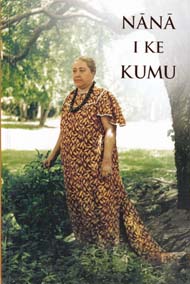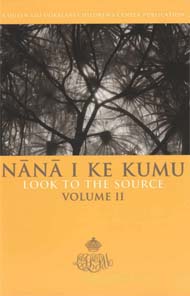Nānā I Ke Kumu
(Look to the Source) Volume I
Mary Kawena Pukui, E.W. Haertig, M.D., Catherine A. Lee
Published by Hui Hānai 1972, reprint 2022
In the 1970s the Queen Lili'uokalini Children's Center worked with principal author Mary Kawena Pukui,
authority on Hawaiian culture and language, E.W. Haertig, M.D., and Catherine A. Lee to publish volumes
one and two of Nānā i ke Kumu: Look to the Source.
Volume one interprets Hawaiian words and phrases associated with specific customs in order to
clarify distorted beliefs, suggest the rationale behind Hawaiian ritual, and convey some of the
poetic imagery of ancient rites and their underlying concepts.
Volume two traces the beliefs, attitudes, and feelings of the ancestors and relates them to
family life today. The authors present Hawaiian concepts and practices related to physical, emotional,
and cultural well-being, specifically related to keiki, kāne, and wāhine, and discussing dreams
and symbols, holiness and healing, shame and guilt, and self-image.
Volume three, published in 2020 by Lili'uokalini Trust, presents ancient and fundamental Hawaiian values
and traditions associated with grieving, as well as healing practices, with the goal of addressing modern-day
family conflict.
Together these three volumes illuminate the wisdom and dignity of our cultural heritage for our people and
provide insight and inspiration for those who work with Hawaiian families throughout our communities.
(The text above comes from the back of the book)
Part about ho'oponopono: Narf.org
Volume II: Ulukau.org
Mary Kawena Pukui was named a Living Treasure of Hawaii
by the Buddhist Honpa Hongwanji Mission of Hawaii in 1977, see:
HongwanjiHawaii.com and
Wikipedia.
Documentary about Mary Kawena Pukui: YouTube
Review
Comprehensive study of Hawaiian traditions written by two Hawaiians: Mary Kawena Pukui and Catherine A. Lee,
together with a western anthropologist E.W. Haertig M.D. The result is an invaluable source of Hawaiian traditions!
In volume 1, an entire chapter is devoted to Ho'oponopono, followed by a more extensive explanation of parts of the
Ho'oponopono process, such as hala, hihia, 'oia'i'o, mihi, kala, mahiki etc.
This book is a must-read if you want to delve into Hawaiian traditions, such as Ho'oponopono.
And, there are no mantra's in this book!
Martin




